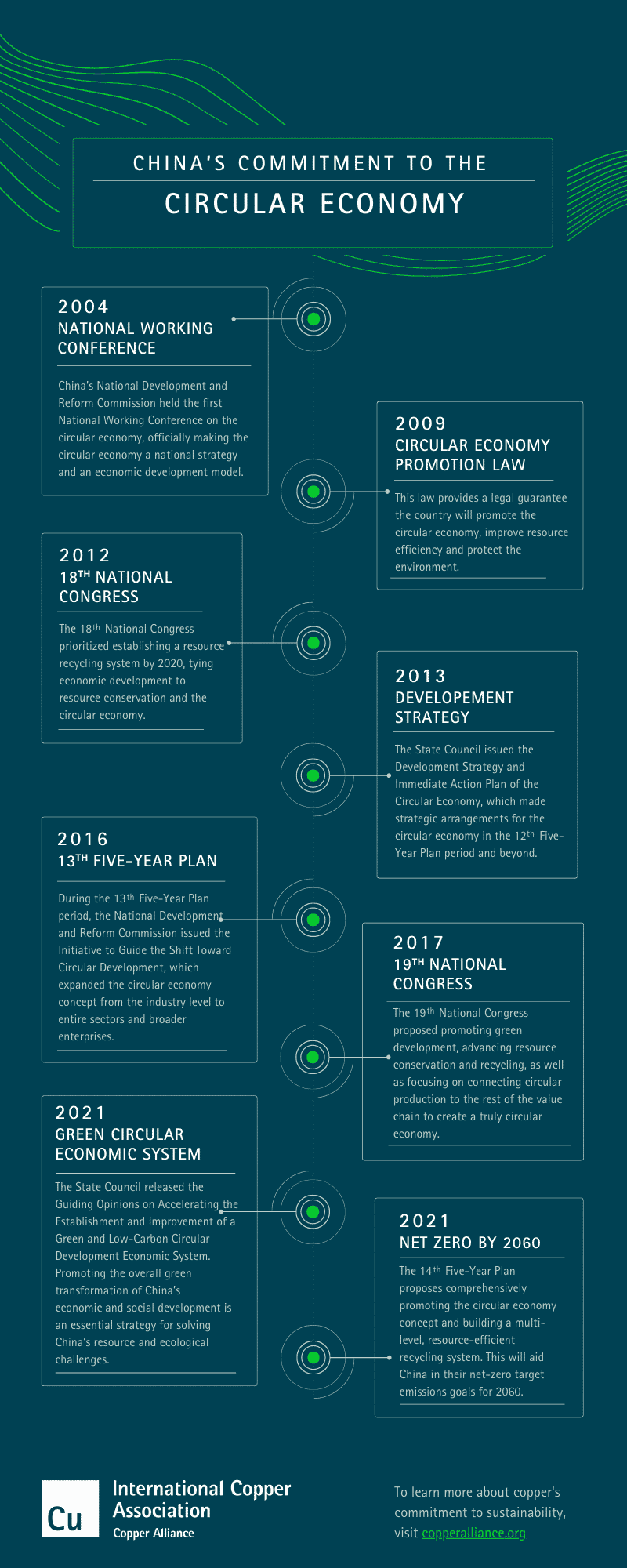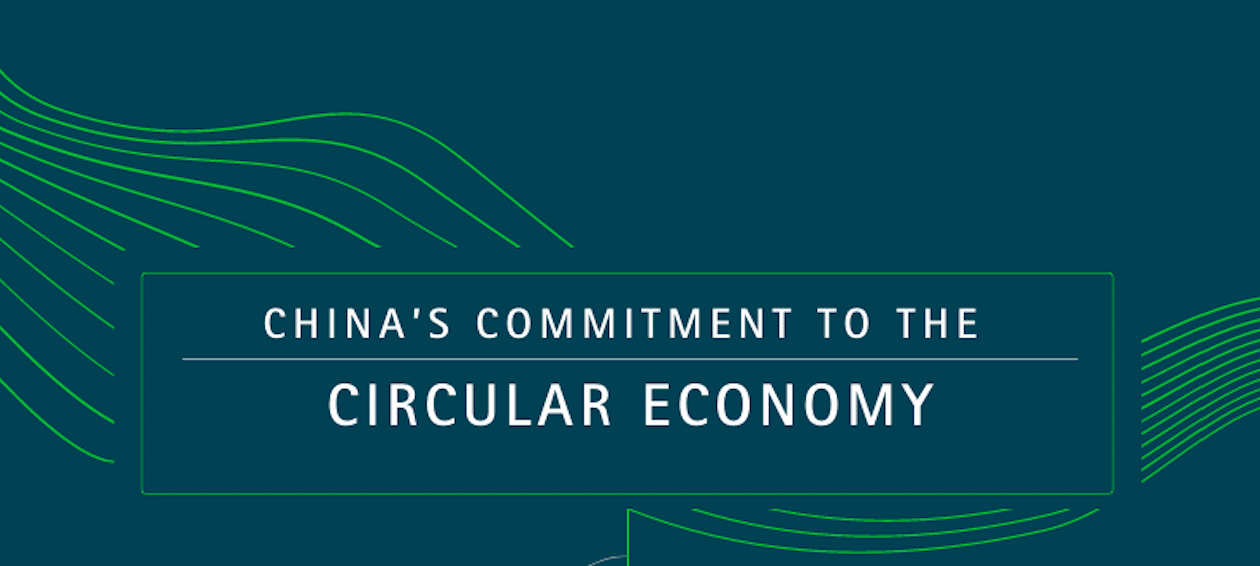Sustainability is at the forefront of China’s plans.
 The 14th Five-Year plan outlines targets for climate action and ambitious commitments for carbon neutrality by 2060. China’s ongoing commitment to the circular economy is a key component in achieving these goals.
The 14th Five-Year plan outlines targets for climate action and ambitious commitments for carbon neutrality by 2060. China’s ongoing commitment to the circular economy is a key component in achieving these goals.
China’s implementation of copper recycling initiatives is a prime example of China’s circular economy in action. China’s urban mining and recycling policies drive copper recovery and efficient resource management, making a significant impact on China’s material demands and sustainability strategies.
CHINA’S DEVELOPMENT OF THE CIRCULAR ECONOMY
The People’s Republic of China has a long history of recyclability initiatives, establishing energy conservation standards in the 1970s. Subsequent resource development and conservation guidelines throughout the 1980s led to the initial policies and regulations relating to the circular economy.
The Chinese government has since made proactive efforts to promote clean production and resource conservation, carrying out various pilot programs in all regions. In 2004, China’s National Development and Reform Commission (NDRC) began coordinating the management of the circular economy. That year, the Commission held its first national circular economy work conference, officially making the development of the circular economy an economic development model and a national strategy.
China made the strategy into law in 2009 with the implementation of The Circular Economy Promotion Law of the People’s Republic of China, providing a legal commitment to developing the circular economy, improving resource utilization efficiency and protecting the environment. China’s first regional circular economy development plan, The Master Planning of Circular Economy in Gansu Province, was approved by the State Council later that year.
China also listed the development of the circular economy as a major strategic task in its 12th (2011 – 2015) and 13th (2016 – 2020) Five-Year plans. To take action on its circular economy model, China launched a series of projects to promote the circular economy, including the “Ten-Thousand-Hundred” Quality Improvement for Excellence initiative, pilot implementations in counties and cities, circular transformations of industrial parks, “Urban Minerals” demonstration bases, resource recycling bases, “waste-free cities” pilot programs and green industry demonstration bases. These initiatives and broader policy action have driven China’s circular economy to new heights of development and effectively promoted the recycling of nonferrous metals like copper.
CIRCULAR COPPER IN CHINA
While China is the world’s largest copper end-use market, its refined copper production accounts for only about one-fifth of the world’s total and 5.5 percent of global copper resource reserves. As China continues to industrialize, China’s copper resource needs will become highly dependent on imports. Copper’s circularity helps to close this gap between supply and demand. With an infinite life cycle, copper can be completely recycled without losing any of its original properties. Recycling scrap copper will help alleviate China’s over-reliance on imported copper and provide a strong guarantee for China’s future resource security. Scrap copper recycling also saves energy and reduces carbon emissions. According to comparative estimates, recycling one tonne of copper is equivalent to saving about one tonne of standard coal, saving nearly 400 m3 of water, preventing 380 tonnes of solid waste and reducing sulfur dioxide emissions by 0.137 tonnes.
China’s circular economy policies and copper recycling initiatives have developed hand in hand. Copper production from recycled copper resources increased from about 19 percent in the 1970s to about 33 percent in the mid-1990s. In the 21st century, China’s copper recycling has grown from more than 300,000 tonnes in 2000 to nearly 2.3 million tonnes in 2015, reaching about 3 million tonnes in 2019.
URBAN MINING FOR “URBAN MINERALS”: DEMONSTRATION BASES ADVANCE CIRCULAR COPPER
Urban mining has been an essential strategy for copper recovery, putting China’s circular economy policies into action. The NDRC and the Ministry of Finance jointly promoted the construction of the national “Urban Minerals” demonstration bases at the beginning of the Twelfth Five-Year Plan period. The bases recover and recycle renewable resources from urban waste and industry, reducing energy use and carbon emissions while contributing to sustainability strategies. The Chinese government approved a total of 49 national-level “Urban Minerals” demonstration bases covering 27 provincial-level regions, more than 80 percent of which are located in eastern and central China. Upon completion, the bases’ renewable resource processing capacity reached more than 40 million tonnes annually. The renewable resources gathered at the bases include metal scraps, plastics, paper, rubber, scrapped cars, glass and electronic products.
As an energy-saving, cyclical and strategic secondary resource, “urban minerals” such as copper exhibit remarkable potential for resource conservation More than 10 bases have copper resource recycling industrial chains, which standardize and integrate smaller copper recycling companies into the larger recycling process. The industrial chains also aid those copper recycling companies facing additional environmental challenges by providing greater access to improved technical equipment. Overall, the copper recycling industrial chains have positively contributed to the development of China’s copper recycling industry.
Copper recycling has occupied a pivotal position in China’s copper industry and will continue to support China’s material demand throughout the industrialization process, making outstanding contributions to China’s economic growth and strategic approach to carbon neutrality by 2060.
 Zhao Kai, MBA, Beijing University. Executive Vice President and Secretary General, China Association of Circular Economy. Zhao Kai provides expertise in leading and guiding government agencies on major circular economy and energy policymaking. He has studied and promoted energy-savings initiatives in China’s industrial and transportation fields for more than 15 years, particularly in the application of the high-efficiency motors, transformers, power cables and other electrical equipment. He is a member of several national policy and standard making committees and has received several prizes in these roles.
Zhao Kai, MBA, Beijing University. Executive Vice President and Secretary General, China Association of Circular Economy. Zhao Kai provides expertise in leading and guiding government agencies on major circular economy and energy policymaking. He has studied and promoted energy-savings initiatives in China’s industrial and transportation fields for more than 15 years, particularly in the application of the high-efficiency motors, transformers, power cables and other electrical equipment. He is a member of several national policy and standard making committees and has received several prizes in these roles.
About the Copper Alliance®
The Copper Alliance is a network of regional copper centers and their industry-leading members. It is responsible for guiding policy and strategy and for funding international initiatives and promotional activities. Headquartered in Washington, D.C., the organization has offices in three primary regions: Europe, Asia and North America. The Copper Alliance has partnerships and programs in more than 100 countries.

